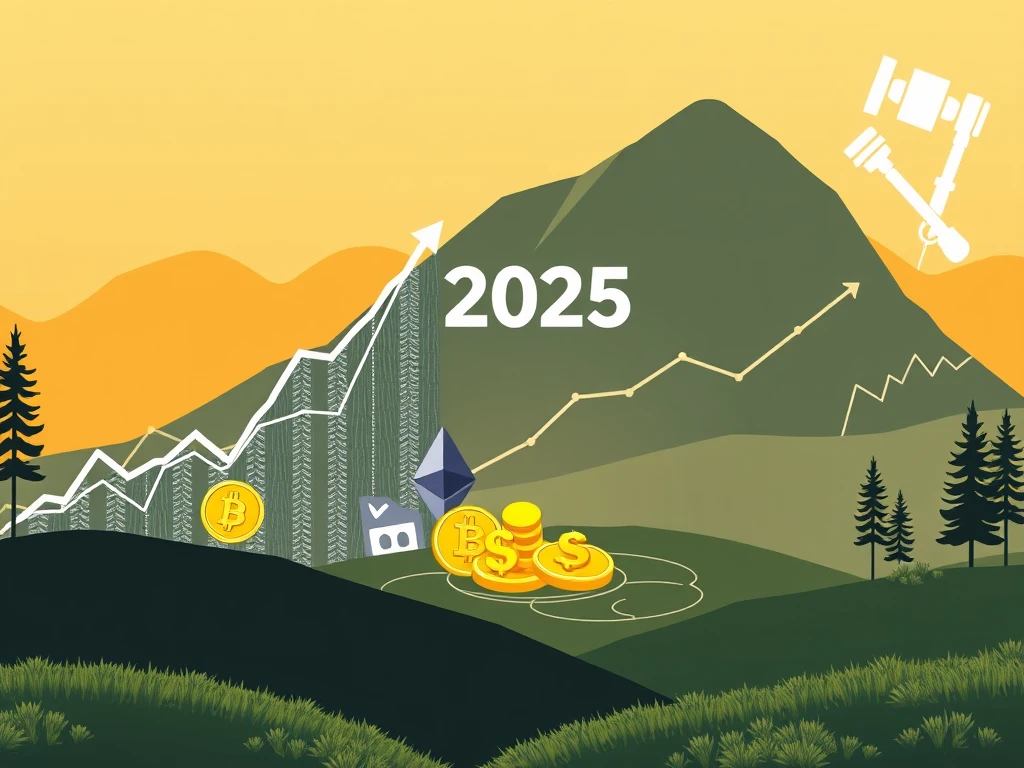Bitcoin Price Surges: April 2025 Crypto Market Highlights

April 2025 delivered a complex mix of market movements and policy developments in the crypto space. While traditional markets faced turbulence, the crypto landscape showed resilience and growth in key areas. This report dives into the significant events that shaped the April crypto market, from price action to regulatory shifts.
Bitcoin Price Performance: A Story of Recovery
Following a period of volatility influenced by external factors, the Bitcoin price demonstrated notable strength towards the end of April 2025. Despite an initial dip in the wake of new US tariffs that impacted global markets, Bitcoin managed to recover and finish the month significantly higher than where it started. By the end of April, Bitcoin was up over 16%, trading near $94,729. This recovery contrasted with the performance of major stock indices, which struggled to regain earlier losses.
Ethereum RWA Tokenization Sees Significant Growth
One of the standout trends in April was the continued expansion of real-world asset (RWA) tokenization on the Ethereum network. Ethereum RWA tokenization value increased substantially, reaching $6.2 billion. This represents a 20% increase just within the month of April. The growing interest from established financial firms, including major asset managers, highlights the potential seen in using blockchain technology for assets like real estate, commodities, and carbon credits. While Ethereum is currently leading in this area, the potential for scaling challenges remains a point of discussion among observers.
Key Developments in US Crypto Legislation
Policy continued to be a focus in April, with progress and new proposals emerging at the state level in the United States. Efforts to shape US crypto legislation saw activity in multiple states:
- Texas introduced HB 5352, proposing a State Blockchain Technology Pilot Program to explore blockchain use in government operations.
- Georgia saw HR 905 introduced, aiming for a K-12 public awareness campaign about blockchain, cryptocurrency, and Web3 technology.
- In Arizona, a bill to expand a regulatory sandbox to include digital assets was vetoed by the Governor.
- However, Arizona did enact a law prohibiting towns from banning or restricting individuals using computational power, including blockchain nodes, in their homes. This provides protection for home-based crypto mining activities.
Stablecoin Market Cap Expansion Continues
Stablecoins demonstrated steady growth throughout April 2025, reinforcing their role in the crypto ecosystem. The total stablecoin market cap increased by $4 billion during the month. This growth aligns with ongoing efforts in various jurisdictions to establish clear legal frameworks for these digital assets. In the US, the STABLE Act, a bill addressing stablecoin issuance and reserves, advanced through a critical committee vote. Additionally, the Securities and Exchange Commission (SEC) closed an inquiry into PayPal’s stablecoin, PayPal USD (PYUSD), without pursuing enforcement action. Market intelligence suggests that stablecoins are increasingly viewed as stable assets during uncertain market conditions, contributing to their rising adoption.
Navigating the April Crypto Market
The April crypto market was defined by resilience in the face of external economic pressures. While US stock markets experienced significant drops tied to new tariff policies, Bitcoin showed its capacity for independent recovery. The month also underscored the increasing practical applications of blockchain, particularly through the growth in Ethereum RWA tokenization. Furthermore, progress in US crypto legislation and the continued expansion of the stablecoin market cap indicate ongoing maturation and institutional interest in the digital asset space. As regulatory discussions continue, these developments from April provide valuable insights into the evolving landscape of cryptocurrency and blockchain technology.
In summary, April 2025 highlighted Bitcoin’s recovery strength, Ethereum’s growing dominance in RWA tokenization, positive movement in stablecoin adoption and regulation, and active legislative efforts at the state level in the US. These trends collectively paint a picture of a dynamic market adapting to both economic shifts and policy developments.








